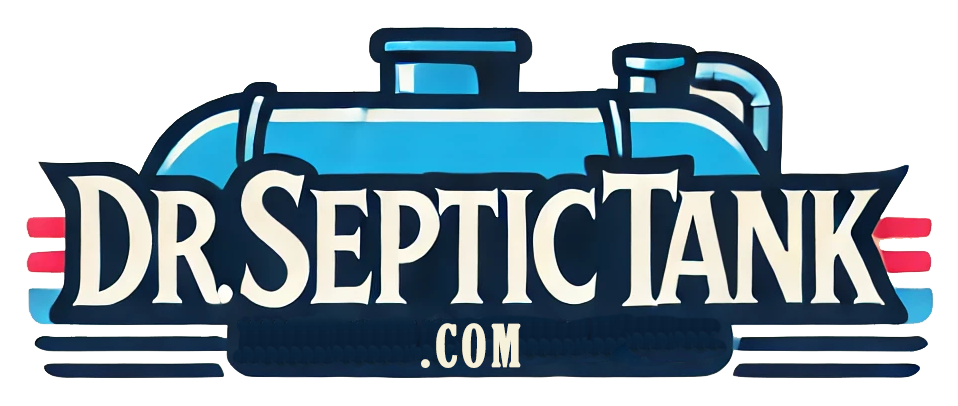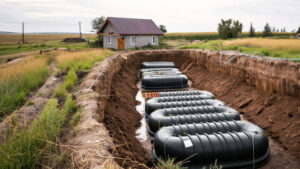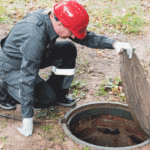How to Check the Health of Your Septic Tank: A Comprehensive Guide
Many homeowners neglect their septic systems until they become a problem. However, regular maintenance and checks can help prevent costly repairs and keep your system running smoothly. In this guide, we’ll show you how to check the health of your septic tank, identify signs of damage or failure, and provide maintenance tips to keep your system in top shape.
Understanding Septic Tanks
A septic tank is a crucial component of many rural and suburban homes’ wastewater systems. It is a watertight container typically buried underground that collects and treats wastewater from bathrooms, kitchens, and laundry facilities.
The tank allows waste to separate into three layers:
- Solids (sludge) at the bottom
- Liquids (effluent) in the middle
- Fats, oils, and greases (scum) on top
The effluent then flows into a drain field, where it is further treated and dispersed into the soil.

Factors Affecting Septic Tank Health
Several factors can impact the health of a septic tank, including:
- Usage: The more people using the system, the more frequently it needs to be pumped and inspected.
- Maintenance: Regular maintenance, such as pumping and inspections, can help prevent buildup and damage.
- Environmental factors: The soil type, water table, and surrounding vegetation can all affect the system’s performance.
- Age of the system: Older systems may require more frequent maintenance and are more prone to failure.
Signs of a Healthy Septic Tank
A healthy septic tank should operate quietly and without any noticeable odors. Other signs of a properly functioning system include:
- Regular operation: The system should operate consistently, without any sudden changes in frequency or volume.
- Absence of foul odors: A properly functioning system should not produce any sewage or rotten egg odors.
- Healthy grass growth: The grass above the drain field should be green and healthy, without any signs of standing water or sewage.
- Clear and odorless effluent: If you can see the effluent in the drain field, it should be clear and odorless.

Signs of a Damaged or Failing Septic Tank
If your septic tank is damaged or failing, you may notice the following signs:
- Slow drains: If your sinks, showers, or toilets are draining slowly, it could be a sign of a clogged or failing system.
- Backups: If wastewater is backing up into your home, it’s a clear sign that your system is not functioning properly.
- Sewage odors: If you notice a strong sewage odor around your home or yard, it could be a sign of a damaged or failing system.
- Wet spots in the yard: Unusually lush or wet areas in your yard, especially near the drain field, may indicate a problem.
- Gurgling sounds: If you hear gurgling sounds coming from your drains, it could be a sign of a clog or system failure.
How to Check the Health of Your Septic Tank
Checking the health of your septic tank involves several steps, including:
- Inspecting the tank for cracks or leaks: Look for any signs of water leakage, cracks, or other damage.
- Checking the sludge and scum levels: Use a sludge judge or hire a professional to measure the levels of sludge and scum in the tank.
- Examining the drain field for signs of failure: Look for any signs of standing water, sewage odors, or unhealthy vegetation.
- Monitoring the water level in the tank: Check the water level in the tank during and after pumping to ensure it’s functioning properly.
- Testing the soil around the tank for contamination: Use a soil test to check for any signs of contamination or damage.
Tip: It’s recommended to have a professional inspect your septic system every 3-5 years to ensure it’s functioning correctly and to catch any potential issues early.
Septic Tank Maintenance Tips
To keep your septic tank healthy, follow these maintenance tips:
- Use a product like SEPTIFIX Drain Dissolver Treatment that is an eco-friendly bacteria drain cleaner for septic tanks.
- Schedule regular inspections: Have a professional inspect your system every 3-5 years.
- Pump the tank every 3-5 years: Regular pumping can help prevent buildup and damage.
- Avoid the use of harsh chemicals: Harsh chemicals can kill the beneficial bacteria in the tank and damage the system.
- Conserve water: Reducing water usage can help prevent overloading the system.
- Be mindful of what goes down the drain: Avoid flushing non-biodegradable items, grease, or excessive amounts of chemicals.
- Maintain your drain field: Avoid planting trees or shrubs near the drain field, and don’t park vehicles or heavy equipment on it.

Conclusion
Maintaining a healthy septic tank is essential for the proper functioning of your wastewater system and the health of your home and yard. By following the steps outlined in this guide, you can check the health of your septic tank, identify signs of damage or failure, and take proactive steps to keep your system in top shape.
Remember, prevention is key when it comes to septic tank maintenance. Regular inspections and proper care can save you from costly repairs and potential health hazards in the long run. Don’t wait until it’s too late – start maintaining your septic tank today!







